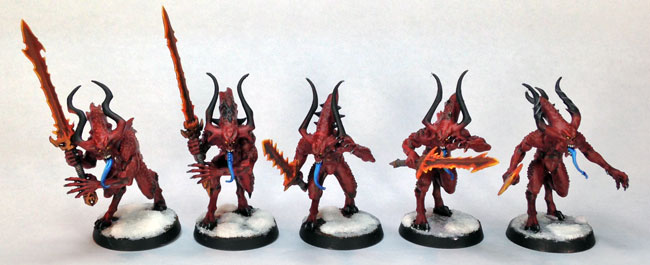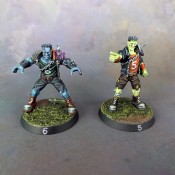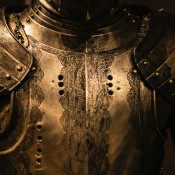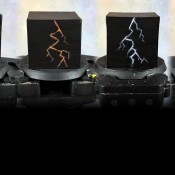Do you want to paint faster? Do you need to get an army finished on a short deadline? Maybe you just don’t care for painting and want to get it done as quickly as possible.
Well, I’m going to share my tips on ways to paint miniature faster to get those models on the table. This will be more useful to newer painters, but there may be a few tips in here that veteran painters might find of use.
Disclosure: Some of the links below are affiliate links, meaning, at no additional cost to you, I will earn a commission if you click through and make a purchase. The commission earned helps maintain this site.
Prime in a Color That Helps You
If you’re going to be painting something that has a lot of dark colors to it, then using a black primer will really help you. Painting dark colors over a white primer takes longer to do, and also the colors never come out as dark as you want.
By contrast, if you’re using a lot of lighter colors, then painting over a white primer will really speed up the process. Have you ever tried painting yellow over a black primer? I have and it sucks. It usually takes a solid 3-4 coats of yellow over black to get a nice clean yellow on there.
If what you’re working on is a mix of dark and light colors, then use a grey primer. Grey works as a great neutral surface to work from. It won’t be as good for light colors as white, or as good for dark colors as black, but it’s right in-between and will split your time between light and dark colors.
I do have a guide to primers if you’d like a bit more information. I’ve also got a quick chart with my top picks for primers.
Accounts
Free Trial
Projects
SSL
Gesso
$
Brush-on
Requires Mixing
Cheapest Option
Brush-on Primer
Easy Cleanup
Badger
$$
Airbrush
Use As-is
Very Affordable
Airbrush Primer
Easy Cleanup
Brite Touch
$
Spray
Use As-is
Very Affordable
Spray Primer
No Cleanup
Washes are Amazing
I’m pretty sure everyone knows about washes at this point. Washes are a huge time saver with miniature painting.
The principle is simple. Get a base coat on whatever it is you’re working on, and then apply a liberal wash to that area. Like magic you get yourself some shading and highlighting!
I know this is an obvious tip for faster painting but it’s worth mentioning. Also, I have a tutorial on using washes effectively. That tutorial will help you avoid common mistakes painters make when using washes so you get the best results possible.
Here’s a video I did for that tutorial if you just want the quick run-through.
Try the Citadel Contrast Paints
I’m going to be honest and admit that I have not used the Citadel Contrast Paints. However, I have seen some amazing stuff done with them with very minimal time investment.
These sort of function like a wash. You apply a liberal coat of Contrast Paint over a lightly primed surface (Citadel has specific primers for this – Wraith Bone & Grey Seer), and you get some nice looking shading, mid-tones, and highlights from it. It’s like if you applied washes over a white primer, which I’ve done in the past, but the Contrast Paints are more effective at it.
Games Workshop has put out a good video tutorial showing how to use these that’s worth watching if you’re interested in this approach.
Rely on Basic Painting Techniques
If speed is a factor for you, then doing things like blending and OSL will be counter-productive. Getting a good tabletop quality paint job with minimal time invested means relying on those basic and fundamental painting techniques like layering and dry brushing, and of course the previously mentioned washes.
If done well, layering can still look great on the table and not take a lot of time or effort to achieve. I’ve got a tutorial on layering that talks about the technique in more depth.
The basic idea is to work up from a darker color to a lighter color. The nice thing with Citadel Paints is they have a system. Each color has a perfect paint to go over it for a lighter layer, or a darker layer, whatever you need. This makes it very easy to figure out what paints you need.
To that end, Games Workshop also has a Citadel Colour app that helps you with these type of color choices. It’s available for both Android and Apple devices.
Dry brushing is a great and fast way to get highlights on models, especially organic type of stuff. I’ve got a tutorial if you need a little help with dry brushing.
Now, the finish with dry brushing can appear a bit dusty though, but there’s a great way to minimize that – washes.
This is applicable to layering as well. If you layer your model, or you apply dry brushing to an area, then going over it with a wash after will not only give you more shading, it will help smooth out those layers of paint or the dusty look of dry brushing. This really helps pull everything to together with a minimal time investment.
Another consideration for speed here is deciding whether or not to do edge highlights. Edge highlighting can add some great contrast to a miniature but it does come at the cost of time.
For a speedy tabletop quality paint job I would suggest skipping the edge highlighting. It’s also something you can come back to later as well. Get the basic paint job on there, and then when you have more time you can come back and do those edge highlights. Nobody ever said you had to get everything done all at once.
Yeah, I’ve got a tutorial for edge highlighting too ;)
Stick to a Minimal Color Palette
The less colors you use the less time you have to spend cleaning your brushes, shaking paints, and getting those paints out for use. I know it’s seems minimal but it’s all time that adds up.
However, the biggest savings is when used with some of the previously mentioned stuff, like washes or dry brushing. If you’re only using a few colors, then you can get all of one particular color on there and wash it all at the same time, or dry brush it.
That way you aren’t needing to rely on 8 different colors for paint and then possibly another 8 different washes for shading, or 8 different colors for highlights with dry brushing. Again, it all adds up.
With this is painting everything identical. Obviously things like uniforms are going to be the same, but I’m talking about weapons, skin colors, helmet lenses, stuff like that. Doing this will let you create an assembly line for painting. Speaking of…
Assembly Line Painting
I admit I hate assembly line painting. However, it really is an effective way to paint a lot of models.
The principle is simple. Let’s say you need to paint a squad of something and it’s all done the exact same way. Get all those models out and ready for paint.
You work through them in an assembly line manner. Paint the pants on one model, set it down, grab the next and paint those pants. Do this until all the pants are done.

Now, go back to the beginning and do all the shirts. Just repeat this process for every part of the model: pants, shirts, boots, skin, etc.
This is mind-numbingly boring to do, but it’s fast and a super efficient way to not only get an entire squad done, it also ensures consistency across the squad.
Cheat Where You Can
There’s a few little things I like to do to cheat when I can.
A big one is painting eyes. Painting eyes is tricky on the best of days, never mind if you’re trying to get something painted in a hurry.
So, for eyes I’ll just paint them entirely one color. If it’s human then I’ll paint it entirely white. If it’s Daemonic than maybe all red. Either way, I don’t bother trying to do in the pupil.
If you’re using a black primer and are painting dark colors, then you can use the primer as shading for your base coat. When you paint your base coat just leave some of that black primer showing in the areas that should be shaded. That saves you a layer of paint.
Another shortcut I like to do is to paint different parts in a similar tone so I can use the same wash over an entire area.
For example, maybe I have a brown leather tunic, and that’s crossed by light brown leather straps, and the shoulders have some bone colored skulls over them. I can wash all of that with a brown wash and it works for all of it. You can even use a brown wash over metal; it totally works.
I feel like I’ve got more cheats but I’m drawing a blank. I’m sure I’ll come back and update this section later.
Use a Wet Palette
While you may not be doing blending or anything complicated when you’re painting for speed, a wet palette of course is extremely useful in keeping your paints from drying out.
The less often you have to get more paint on your palette the more time you spend painting. The wet palette will keep your paint workable for the entire duration of your painting session. It’s that simple.
If you want to make your own wet palette, then check out my tutorial on just that.
Use the Right Brushes
Basically, use the right brush for the right job.
If you’re laying down a base coat, then use a nice, large base coating brush. You want something that holds a lot of paint, and in turn requires less reloading of paint, but also covers a large areas quickly.
Don’t worry about being sloppy when you start base coats. You can always clean that up with the later layers you add.
If you’re painting a lot of tanks, or anything with large flat surfaces, then get yourself a 1″ flat brush, don’t use your normal base coat brush. That will save you from having to load up on paint and it’s going to cover more surface area faster.
Now, the same is true of brushes on the other end.
Once you’ve got more paint on the model, and the chance of messing up a previously painted area is higher, use brushes that offer you more control. They don’t need to cover as quickly once you’ve progressed into having more areas on the miniature painted.
The goal is to not make mistakes. Mistakes require time to fix.
Get Decent Paint Brushes
With the previous tip comes getting yourself some decent paint brushes. You don’t have to spend a lot of money; there’s some really affordable options.
I cover this topic in more depth in my paint brush guide, but don’t use really cheap brushes. Really cheap brushes you buy at a major retailer like Walmart are not worth the money. Sure, they’re cheap to buy, but they wear out quickly, don’t hold paint well, and over virtually no control.
Definitely check out that linked guide for some more info. Also, here’s a quick chart showing my top 3 picks for paint brushes ranging from cheap to expensive.
CHOOSE
Your Plan
Disk Space
Databases
Domains
Users
Price
Loew-cornell
Beginner painters
Cheap
Easy to find
Low Quality
Short lifespan
3
value
citadel
intermediate painters
Inexpensive
easy to find
Good quality
Good lifespan
7
value
Raphael 8404
advanced painters
expensive
harder to find
Great quality
Long lifespan
10
value
Invest in an Airbrush
I do not have an airbrush, however, I do plan to get one eventually. I don’t have a big need for one since I’m not mass painting armies any longer, but I could still make use of one.

An airbrush is an investment for sure, but if you have a lot to get painted, then that investment can really pay dividends.
Airbrushes let you lay down base coats really fast. With some practice and control you can learn to paint most of a miniature with one. Then you come in with a paint brush for the final details.
Airbrushes, in my opinion, excel with things that have a lot of large flat surfaces like tanks. Using a brush, even a big one, can take a long time to get a tank base coated. An airbrush will do a better job at a fraction of the time.
It’s possible to even use washes with an airbrush. You can prime models with them and even seal/varnish with them as well. Again, it’s an investment but it will pay off pretty quickly.
Conclusion
I’m sure if I sat and thought long enough that I could come up with 11 more tips, but I feel this really covers the big ones.
Hopefully you found some useful tips in here!
Do you have any tips you’d like to share for painting faster? I’d love to hear them below in the comments!
- Creative Twilight’s Future and My Thoughts (Feedback Welcomed!) - December 4, 2021
- My Top Gift Ideas for Miniature Painters & Hobbyists + Gifts to Avoid - December 2, 2021
- The Year That Was 2020 and Where I’ve Been - January 17, 2021





Lots of good tips there.
Thanks. There’s really no one thing that speeds up painting, just a combination of a lot of things, all of which save a little time, which then adds up to something significant.
Do you know anyone who paints military miniatures in Virginia.? Would like to start lessons. thanks.
Unfortunately I don’t know of anyone in that area.
assembly line painting is mind numbing and can be hellish.
When you first try this method find your number start with 5 miniature’s and go through the whole process, then try 10,then 15 ect. Till at some point it will be to much! For example for me 10 is my max and I no longer attempt 15.breaking it up like this makes it doable and thus finish able.
However I’d still prime the lot first
When painting start with the base skin tone and work out if you can see a vest that’s next shirt and trousers next then webbing finally boot’s and gun.
Then mid tones in the same order
Then highlights.
Doing in this order mean’s you can correct mistakes as you go
All good advice.
My breaking point is 5. I can’t do that more than that without going nuts.